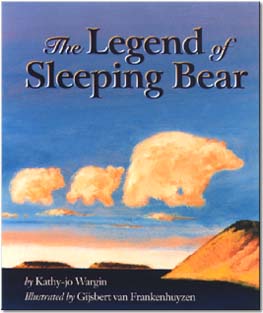






Long, long ago, before voyageurs paddled canoes down rivers and streams, before mighty lumbermen cleared forests with sharp, shiny axes, before wooden ships carried sailors across great freshwater seas, there was a beautiful forest at the edge of a mighty lake. That mighty lake was Lake Michigan, the forest part of Wisconsin and these words from the newest retelling of the classic tale of a Mother Bear and her two cubs fleeing a forest fire: The Legend of the Sleeping Bear written by Kathy-jo Wargin and illustrated by Gijsbert van Frankenhuyzen. For those unfamiliar with the legend, a brief synopsis of the Ojibwa tale is probably in order: A mother bear and her two cubs flee a Wisconsin forest fire by attempting to swim to Michigan. The mother makes it, her cubs do not. She waits on the sandy shore for her cubs. The Great Spirit takes pity on her and raises her cubs up from the depths, forming North and South Manitou Islands. It's one thing to say it, but quite another to see it laid in front of you in the simple but compelling words of Wargin and the rich paintings of Frankenhuyzen. The book has already become a strong seller at area book stores. Susan Cordes of Leelanau Books has an idea why: "I read this book to some children from the Children's Center and you could see them get lost in the pictures and story. At the point when the little bears disappear beneath the water, one of the kids asked with some concern: 'But Mrs. Cordes, where are the bears?'" Heather Hughes of Sleeping Bear Press was the book's editor and admitted that they were concerned about the reaction of children to the powerful story. "This is the first children's book we've done and when I was told the legend, I knew that it had to be the first. We did not want the book to end with a
Gijsbert van Frankenhuyzen was drawn by the story as well. "I came to the United States in '76 to work for Michigan Natural Resources Magazine. When I first started, the editor told me about the Sleeping Bear and gave me a car to tour the state. I've probably seen more of Michigan than most folks who were born here. When they asked me to do the book, I didn't even have to think, just told them: 'You bet I am! If you asked me what I'd be doing rest of my life, it would be illustrating books like this" Gijsbert's paintings (done in acrylic on canvas) enhance the tale and the layout of the book uses them well as full page illustrations. The story, simple yet powerful, is the kind that kids will clamor for, again and again. |


